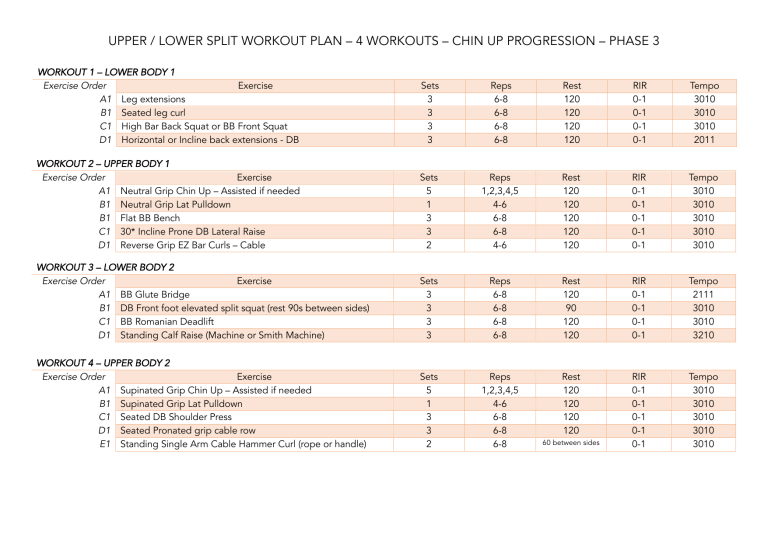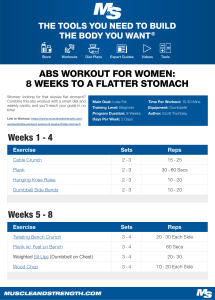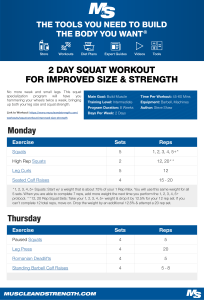
UPPER / LOWER SPLIT WORKOUT PLAN – 4 WORKOUTS – CHIN UP PROGRESSION – PHASE 3 WORKOUT 1 – LOWER BODY 1 Exercise Order Exercise A1 Leg extensions B1 Seated leg curl C1 High Bar Back Squat or BB Front Squat D1 Horizontal or Incline back extensions - DB Sets 3 3 3 3 Reps 6-8 6-8 6-8 6-8 Rest 120 120 120 120 RIR 0-1 0-1 0-1 0-1 Tempo 3010 3010 3010 2011 WORKOUT 2 – UPPER BODY 1 Exercise Order Exercise A1 Neutral Grip Chin Up – Assisted if needed B1 Neutral Grip Lat Pulldown B1 Flat BB Bench C1 30* Incline Prone DB Lateral Raise D1 Reverse Grip EZ Bar Curls – Cable Sets 5 1 3 3 2 Reps 1,2,3,4,5 4-6 6-8 6-8 4-6 Rest 120 120 120 120 120 RIR 0-1 0-1 0-1 0-1 0-1 Tempo 3010 3010 3010 3010 3010 WORKOUT 3 – LOWER BODY 2 Exercise Order Exercise A1 BB Glute Bridge B1 DB Front foot elevated split squat (rest 90s between sides) C1 BB Romanian Deadlift D1 Standing Calf Raise (Machine or Smith Machine) Sets 3 3 3 3 Reps 6-8 6-8 6-8 6-8 Rest 120 90 120 120 RIR 0-1 0-1 0-1 0-1 Tempo 2111 3010 3010 3210 WORKOUT 4 – UPPER BODY 2 Exercise Order Exercise A1 Supinated Grip Chin Up – Assisted if needed B1 Supinated Grip Lat Pulldown C1 Seated DB Shoulder Press D1 Seated Pronated grip cable row E1 Standing Single Arm Cable Hammer Curl (rope or handle) Sets 5 1 3 3 2 Reps 1,2,3,4,5 4-6 6-8 6-8 6-8 Rest 120 120 120 120 RIR 0-1 0-1 0-1 0-1 0-1 Tempo 3010 3010 3010 3010 3010 60 between sides UPPER / LOWER SPLIT WORKOUT PLAN – 4 WORKOUTS – CHIN UP PROGRESSION – PHASE 3 WORKOUT WEEK - SCHEDULE Monday Lower 1 Tuesday Upper 1 Wednesday Rest Day Thursday Lower 2 Friday Upper 2 Saturday Rest Day Sunday Rest Day *Note, workouts can be done on any days, but ideally would maintain the above pattern if possible WORKOUT TEMPLATE - EXPLAINED Exercise Order Exercise Sets Reps Rest RIR Tempo A1 Seated BB or DB Shoulder Press 3 6-8 120 0-1 4010 B1 Exercise Order: This simply refers to what order the exercises are to be completed in. If an exercise starts with the same letter as the exercise before or after it (e.g A1, A2), then these exercises are performed as a ‘pair’, meaning you will perform 1 set of A1, rest the time that is specified, then perform 1 set of A2, rest the time that is specified, and return to A1. If the is only one exercise with that letter (e.g. A1, B1), then the A1 exercise is performed as a ‘straight set’, meaning you complete a set, rest the specified amount of time, and complete your remaining sets before moving onto B1. Exercise: This is the name of the exercise you will be completing, this includes whether you should use DBs, BB, Machine, or Cable. If you do not have access to this exercise, then try and pick the most similar variation available (e.g. if you don’t have DB’s, then performing the same exercise with a BB is an adequate substitute). Sets: This refers to how many times you complete the assigned ‘reps’. E.g. if you have 3 sets of 8 reps, you will complete 8 reps, rest the time specified (that is 1 set), you then repeat this two more times for 3 sets in total. Reps: This refers to how many times you are completing the lift in a given set. If you have a rep range (e.g. 6-8) this means that you want to pick a weight that will land you in that range when you take it to the prescribed RIR. If you are only able to complete 6 reps, then you may choose to use UPPER / LOWER SPLIT WORKOUT PLAN – 4 WORKOUTS – CHIN UP PROGRESSION – PHASE 3 that same weight next workout but aim for 7 or 8 reps. If you are able to complete all 8 reps, then next session you will try and increase the weight an aim for at least 6 reps. This gives you two opportunities for progress, increasing reps within the given range, or increasing weight. Rest: This is the rest period between sets. It is important that you take this rest period and do not cut it short. This is taken after every set. This is set in seconds (e.g. 120 = 2 minutes rest). RIR: Reps in Reserve; this refers to how close to failure a set is taken. 0-1 reps in reserve does not necessarily mean ‘failure’, simply that you were unsure whether you would be able to complete another good quality repetition. Generally if I say 0 RIR then I want you to go to failure – the point where you fail mid rep. If I say 0-1 then I want you to stop when you performed a quality rep but don’t attempt another rep if you are not sure if you can complete it or not. Tempo: This is your lifting cadence. This can be broken it 4 segments (or 4 numbers). Each number represents that part of the lifting phase (in seconds). 4 - - - The first number is the ‘eccentric’ or lowering part of a lift. This represents the part where you are resisting the weight. This is generally the way ‘down’ in a machine or free weight, however in a pulley exercise this may actually be the upwards motion (e.g. a lat pulldown). Think of this is the part of the lift where the muscle is lengthening, rather than lifting / shortening. - 0 - - The second number is the ‘pause’ in the bottom or lengthened position. A zero means no pause. This pause takes place immediately after the eccentric. E.g. in a squat, the ‘lowering’ part is the first number, and the pause at the bottom (if any) is the second number. - - 1 - The third number is the ‘concentric’ or lifting part of a lift. This represents when you are actively lifting and contracting / shortening a muscle. In the squat example, this is the part after you have lowered the weight and where you are now lifting the weight back up to the starting position. In general, we want to do this part of the lift as fast of explosively as possible but maintain control. Think of a ‘1’ as ‘explosively controlled’ (e.g. I don’t want you to lose your balance or compromise your technique because you are trying to explode). - - - 0 The fourth and final number is the ‘pause’ in the top or shortened position. Again, a zero means no pause. This pause takes place immediately after the concentric of ‘lifting’ part of the lift. In the squat example this would be after you have lifted the weight back to the starting position and are standing fully upright.





